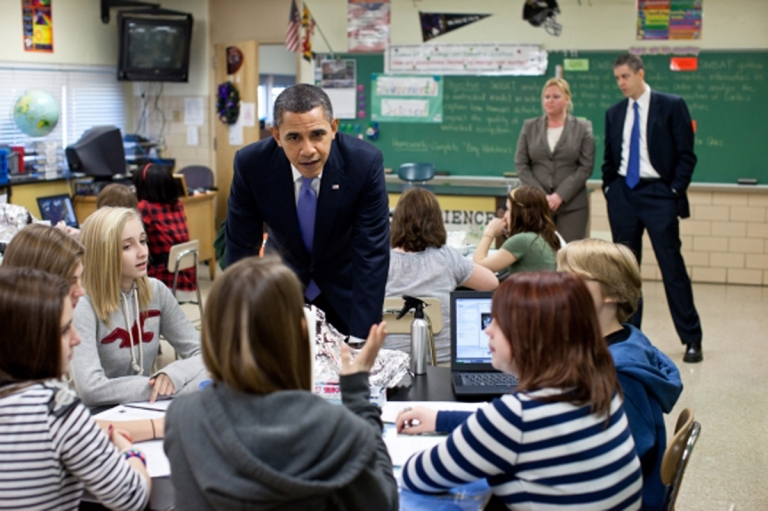Mo’ students, mo’ money, mo’ jobs?
President Obama announced his Youth CareerConnect program, which would fund innovative education in 24 schools with $107 million total. The Washington Post reported Monday that this initiative will help students gain the work experience they need to enter the labor force:
Twenty-four awards, totaling $107 million, will be given across the country to partnerships of education agencies, workforce investment boards, universities and corporations to help them redesign learning so students will graduate “with the knowledge, skills, and industry-relevant education needed to get on the pathway to a successful career, including post-secondary education or registered apprenticeship,” according to a White House official.
How students are to be educated has been a long-term issue. Just look at Common Core, which is a list of standards, but has parents posting angrily online about worksheets that have barely changed since I was in elementary school.
The debate over whether American education needs to be restructured is an adequate one. Currently, high school education leads to more questions than answers about careers, and may direct students into a standard or a box that doesn’t fit them. Careers outside the college environment are sometimes more fitting for some students than others.
Obama’s grant program started last year in collaboration with the Departments of Labor and Education. Obama’s visit to Bladensberg High School accentuates his plan to potentially use his executive authority against Republican wishes.
Part of what makes this program valuable is the focus on internships and career development. Steve DeWitt, deputy executive director at the Association for Career and Technical Education, said that Obama is highlighting issues in student preparedness for careers through education, something he currently calls the “skills gap.” He told the Post:
A lot of our members would likely say, ‘Finally there is more recognition for post-secondary programs’…It needs to be about multiple pathways for students. That’s what needs to happen to improve education and the economy.
Obama told NBC that the outlook is optimistic for students (and that’s sarcasm).
“You guys are all coming up in an age when you’re not going to be able to compete with people across town for good jobs,” Obama said to NBC. “You’re going to be competing with the rest of the world.”
The bigger problem that has been noted is the drop out in students interested and pursuing jobs in science, technology, engineering, and math, or STEM (read an argument for it here).
Two school systems in the news recently that implement policies to move toward technical and vocational school are in New York and Louisiana. In New York, PBS reported that the Pathways in Technology Early College High School (P-TECH) plans to keep students in high school for six years instead of four so students can acquire their Associate’s degree of Applied Science, through state funding and IBM investment.
Louisiana’s Jump Start program to provide career education has “drawn interest from 52 of the state’s 70 public school systems” according to The New Orleans Times-Picayune. Through this program, students connect with businesses and colleges in an effort to de-stigmatize “career education” over the generalized or college-minded educations.
The Post Bulletin reported that Minnesota has been trying to implement a more career/technical system for years, and has been succeeding in getting more students involved in the workforce.
How to educate children into an environment that will fit their talents and the needs of society is not a new issue. An article in Pearson’s Learning Curve, stated that stacking these two learning types in opposition would be wrong, but that another option for students who would otherwise drop out is never a bad idea:
Vocational education may not help students earn – or contribute to the economy – more over their lifetime, and too specialised a curriculum may make them less prepared to cope with rapid technological change. Nevertheless, by providing an educational pathway for those who otherwise would drop out, they are likely to be well worth the additional cost.
Already, most high schools offer Regional Occupational Programs for technical training for students. Now, this EdSource article from January argues that ROP is being dropped for the career and college track, instead of providing necessary blue collar jobs in communities.
Students need to be plugged into a system of education, whether it be technical, skills-based, or discovered through higher education. Engaging students in the workforce to help them survive in today’s society is an admirable goal. How that happens without draining taxpayer dollars may revolve around the idea of de-stigmatizing the so-called lesser pursuits of community college and vocational education.
Mark Philips, a teacher and educational journalist, makes a fantastic point when he explains the educational destructiveness to children and society of treating vocational education negatively. In 2012, he blogged in Edutopia:
They [students] should have the opportunity to be trained in whatever skills their natural gifts and preferences lead them to, rather than more or less condemning them to jobs they’ll find meaningless… Many of the skills most needed to compete in the global market of the 21st century are technical skills that fall into the technical/vocational area. The absence of excellence in many technical and vocational fields is also costing us economically as a nation.
The Chronicle of Higher Ed stated in its article that the conversation must start between “the higher-education community and future employers in business and the nonprofit community, and acknowledging that higher education fails in its mission if it trains graduates only for their first postcollege job.”
One size does not fit all. Look at Logan, a home-schooled student who is gearing his education toward things he enjoys and specializing it at 13 years-old. He calls it hackschooling. Our education system needs to start reflecting that creativity, flexibility and individuality in some way, or else the workforce may continue to lose professionals, both white and blue collar, to unemployment and an uninspired educated class.


